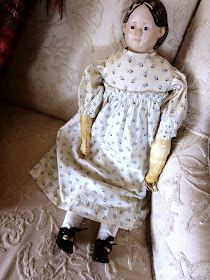On Cape Ann I knew a family who frequented the same small family beach where my family spent long summer days.
The acquaintance from Cape Ann fancied herself to be psychic. I saw her reading books on the subject as she watched her kids on the beach. I have to say I was pretty skeptical about the whole subject and this person in particular. She couldn't be serious! I did not know that these two couples were acquainted with one another until my Newburyport friend told me this strange tale
The couple from Cape Ann were invited for dinner in Newburyport at the house with the large fireplace. After dinner the two couples sat around the fireplace chatting until right out of the blue the psychic from Cape Ann insisted that there was an old shoe in the fireplace. At this point members of the group gathered at the opening of the fireplace and began to poke around either on the sides or up in the mouth of the flue. (I'm not sure of the details). And sure enough: there was the shoe! A very old shoe it was.
What a story. I could hardly believe it. Certainly the credentials of the Cape Ann lady as a psychic were substantiated. There was no way I could forget this strange incident.
Many years went by, I would say at least twenty five. During these years I had been increasingly involved in old houses. Little by little I began to hear stories of ancient shoes being pulled out of chimneys or walls until eventually it was acknowledged that this was more than mere coincidence. How many shoes were found and tossed into the trash or dumpster before it was recognized that this was happening on a regular basis?
Richard Irons, restoration mason, can vouch for many having been unearthed as he restored ancient chimneys and their fireplaces.
One day Richard Irons and his crew arrived at the home of a friend in Gloucester to go to work on the chimney as the house was being restored. Half serious and half in jest, my friend said to one of the workers, "Let me know when you find the shoe." Not long afterward the worker appeared and said to my friend, "Here's your shoe!"
As might be expected, back in the 18th century, nothing was squandered or wasted. Hence, the concealment shoes, when brought into the light of day for the first time in 250 years, give or take a few years, are pretty battered and worn; partly from age but mostly because any shoe that they sacrificed would have been completely worn out or they would not have been relegated to the chimney.
Strangely enough, although this custom can be documented back to Europe and England, until fairly recently there had been little written about the custom or attention given to the regularity and frequency in which it occurred. The average person, even preservationists had never heard of such a thing,
The early settlers around here had roots mostly in East Anglia. Wikipedia shows a photo of many shoes found in the region and there is even a Northampton Museum featuring concealment shoes. Even National Geographic has acknowledged them. This long forgotten tradition from an earlier more superstitious time is no longer a secret.
In April 1999 the magazine, Early American Homes, published the following. It sums up the tradition that was right under our nose but the story of concealment shoes literally "fell through the cracks".
Considering how widespread and long lasting this folk belief has been, it is curious that nowhere was it described in writing until references began to appear in mid-twentieth century archaeology literature in scholarly journals. Some speculate the tradition of hiding shoes was a male superstition, kept secret almost out of fear that telling about it would reduce its effectiveness. Others feel contemporary writers did not describe it since superstition ran counter to prevailing religious beliefs and the Puritans punishment of witchcraft and magic was well-known.
When removing walls especially around windows and doors, under roof rafters and behind old chimneys, homeowners should be aware of the possibility of turning up concealment shoes. While most are found in eighteenth and nineteenth century homes, a find hidden as late as 1935 has been reported. If shoes are found, they should left exactly as they were discovered and photographed. Items found with the shoes are as important as the shoes themselves and should also be saved.
If you are restoring an old house or even just the chimney be aware that you may find a shoe. You may be shocked at its worn, dilapidated and twisted condition but don't let your contractor toss it in the trash. How would they know or think that it was an archaeological treasure unless you tell them to look?
Think of the thousands upon thousands that have been thrown out as trash.
If you have an old shoe story please share it!
Happy hunting,
Pru
NOTE: Here are more concealment shoes found right here in Gloucester at the Sargent House Museum. See links in comment section below. Thank you Kimberlee.
Any more shoes out there that you would like to share?
NOTE: Here are more concealment shoes found right here in Gloucester at the Sargent House Museum. See links in comment section below. Thank you Kimberlee.
Any more shoes out there that you would like to share?
 |
| Shoes at the Sargent House Museum here in Gloucester. |































